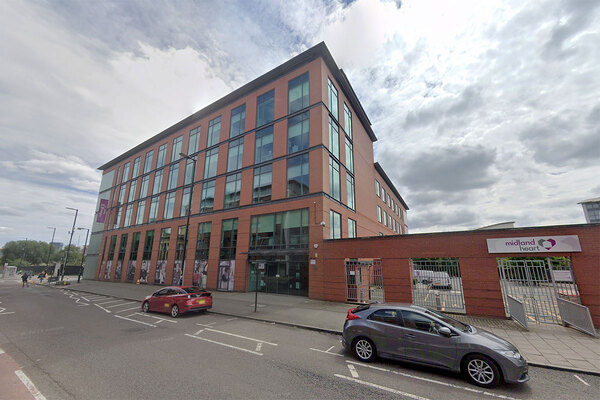You are viewing 1 of your 1 free articles
A vision of the future? We visit a ‘modular town’
Two large developments to house 1,500 power station workers have sprung up in just over a year. Martin Hilditch visits to see if the offsite scheme is a vision of the future.
Caledonian Modular’s timber-clad properties at Hinkley Point
In the construction world’s equivalent of the blink of an eye, a new settlement has sprung up on the outskirts of the historic Somerset town of Bridgwater.
The Bridgwater Campus development is made up of 29 blocks of low-rise housing and will accommodate 986 people working on the nearby Hinkley Point C nuclear power plant (temporarily increasing Bridgwater’s population by roughly 3%).
It started on site in November last year and, when Inside Housing visits at the beginning of September, the finishing touches are being made ahead of residents moving in next month. As Paul Lang, chief executive of offsite manufacturer Caledonian Modular, states, the campus is basically “a small town”.
“It was a green field less than 12 months ago,” he says.
While a quick look at Google Maps suggests the site was not a very green field prior to the development, the point stands about the pace of delivery. The buildings, clad in several shades of grey, form one half of a pair of modular developments in the area. A short hop down the road, Caledonian has already delivered 15 further buildings, this time timber-clad. Between them, the two developments – which cost £50m – will house 1,500 key workers needed to construct two new nuclear reactors at the nearby Hinkley Point C power station.
Inside Housing has come to look at this scheme because it has managed to deliver something that social landlords in England thus far have, by and large, not – a large-scale offsite development.
Our survey of the top 50 biggest builders this year found that the sector built just 4,667 homes using modern methods of construction in 2017/18 (or three Hinkleys, if you prefer). This represented 13% of the total and a tiny fraction of the 300,000 homes a year that the government wants to deliver.
In its 2017 Housing white paper, the government suggested that offsite homes can be built up to 30% more quickly than traditional methods and said that ministers want to stimulate use of these methods to increase overall delivery.
Inside Housing wanted to explore one of the largest offsite schemes in England in a bid to find out more about its delivery and explore what light the modular developer behind it can shed on why the social housing sector has been slow to embrace modular to date.
With handover of the site only weeks away, Inside Housing visits on a busy day as finishing touches are made to the buildings (although these were 96% completed in Caledonian Modular’s vast factory in Newark, Nottinghamshire, according to the company). We tour the site with Debansu Das, Caledonian Modular’s residential sector lead, and Steve Tate, its project director.
“It’s been hard work,” Mr Tate admits, as we talk about the pace of delivery while sticking closely to the designated walkways, several site vehicles trundling past.
“We started on this site in November and we put the last module in on 12 July. It was actually four weeks ahead of schedule.”
Typically about seven modules were installed on site a day. When the basic integrity of the building is completed and temporary electrics put in, a stream of workers such as joiners, electricians and plumbers come in – a process that takes five or six weeks.
By the time finishing touches like decorations, carpets and ceiling tiles are added and electrics switched on, about 10 weeks has been spent installing an individual building on site, Mr Tate suggests. “That is literally the point where the door buzzers are working, the fire alarm is on and you are ready to move in if you want,” he states.
While the scheme itself is yet to see people take up residence, the buildings – which, because of their specific time-limited function basically contain hotel rooms with en suite bathrooms for each worker – were completed in the factory in March this year.
To avoid problems three of the completed buildings were stored in dockyards in nearby Avonmouth (at least, nearby compared with Newark).
“The biggest risk you have as a modular business is getting the product from the factory to the site and getting it installed,” Mr Tate says. “So on a large job we like to bring some of the assets close to site.”
The Bridgwater Campus contains 29 blocks of low-rise housing and will accommodate 986 people
He adds that work on the site has been “like clockwork”.
“If a computer was to decide how to build buildings this is how we would do it,” he adds.
“Rather than take lots of labour and individual components to a remote site we would construct the building in a controlled, cellular format and then take the whole thing to site.”
The computer, however, is clearly saying ‘No’ more often than ‘Yes’ in the social housing sector, where, as mentioned, offsite provision is still a relatively minority activity. So what’s holding people back?
Bad forward planning is one of the main reasons, Mr Tate believes.
“In my experience what puts clients off is that you need to have a design brief very early,” he says. “You need to know what you want. And not many clients know what they want until after they have got it.”
There are clearly other concerns too. Zurich Insurance raised some of these in its written evidence to a House of Lords Science and Technology Committee inquiry into offsite manufacture this year.
In its evidence it states that: “Trends are emerging around serious problems that can be experienced when implementing modern methods of construction (MMC), particularly issues relating to the durability of the development, and the increased risk of larger-scale flood and fire damage.”
Zurich raises concerns that “the use of combustible lightweight materials such as wood, polystyrene and recycled materials have the potential for a greater degree of fire spread, leading to an increase in repair costs and timescales”.
The insurance company states that it would like to see “clearer and simpler building regulations and the need for clear enforcement mechanisms to ensure that new buildings built using MMC are truly fit for purpose”. And its evidence adds that “developers and owners need to consider how the use of MMC will affect costs during the lifespan of the building”.
Mr Tate agrees that the clarity of some regulations could be improved but says that Caledonian’s testing with international fire consultants demonstrated that each individual room would contain a fire for an hour – as required – before it could spread.
He says there has been more scrutiny than usual from the company’s external partners too, given that the job commenced shortly after the Grenfell Tower tragedy.
“This job in particular has been scrutinised because of Grenfell,” he states. “Everybody was all over it.”
Construction site at Hinkley Point C nuclear power station
While the Bridgwater Campus was designed to last for the 10-year duration of the work at Hinkley Point C, Mr Das says that Caledonian’s housing products are designed for at least 60 years’ durability – and that clients should carry out normal due diligence before signing up with any contractor.
For Mr Das, the relatively slow pace at which the social housing sector is embracing offsite construction is probably “a fear of the unknown”.
“The right noises are happening but getting it over the line takes a different attitude,” he states.
“We are working with a few housing associations where there are a few internal champions but we need more of them who understand the process,” he adds. “I think the housing sector is still gearing up towards it.”
Housing providers may have different opinions of course. Swan Housing Association, which set up its own modular factory, also provided written evidence to the House of Lords inquiry. It says it was influenced to do so because it believes the “existing market [for modular] was quite immature and had limited capacity” along with “very high overheads, which we believed arose from the need to build in contingency for lack of continuity of work”.
“All these people [in the social housing sector] are waiting to see a large project being delivered Debansu Das" Caledonian Modular
The Hinkley Point developments certainly suggest that there is some existing capacity out there.
While social housing providers may be embracing offsite with some caution, Caledonian’s chief executive Mr Lang says there is “huge momentum” in the private rented and build-to-rent sectors. At the moment it is in these parts of the housing market that the company sees the majority of its sales opportunities arising in the short term. “They can see the quality benefits of having it done in a factory,” he states.
Despite noises from the government, Mr Lang says he thinks it has taken little meaningful action to push offsite forward.
Mr Das agrees – and ultimately he says he thinks it is the government that holds the key. “All these people [in the social housing sector] are waiting to see a large project being delivered,” he states. “I think it would be great if the government saw the scope for an exemplar project on scale. The government needs to take the initiative.”
The hotel-style blocks may be different from the type of accommodation a social housing provider would look to provide, but it delivers on the scale Mr Das is talking about. And it is easy to see how a similar approach could work for large housing schemes. Certainly if government rhetoric translates into action, Bridgwater Campus is the shape of things to come.
For now though, there is a job to be finished before the workers at Hinkley Point C can start to move into their new homes from their current residences. There should be no nasty surprises for the client, EDF Energy, when it comes to handover, however.
“They saw the product in the factory,” Mr Tate says. “They essentially signed it off before it got here.”














